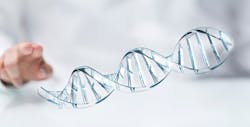A team of researchers at three University of Michigan labs have been able to track how a protein binds to its chromatin substrate within a living cell by establishing a collaboration that combines state-of-the-art ultra high-resolution imaging, synthetic protein design and computational modeling. Their results are published in Science Advances.
Cells control how and which genes are expressed from a copy of the DNA sequence held within each cell, despite that sequence being the same across all cells in the body. One way they control expression is by changing how tightly the DNA is packaged within the nucleus using proteins called "histones." Histones can be modified through the addition of small chemical tags that regulate how tightly the DNA is wound around them and thus whether the genes can be expressed.
Proteins that have the ability to read, write and erase these histone tags explore the DNA within the nucleus of the cell very rapidly—on the order of milliseconds, according to lead author Kaushik Ragunathan, Ph.D., assistant professor of biological chemistry at the U-M Medical School.
Ultimately, all this epigenetic information needs to be inherited across generations, but the recognition of these tags is a complicated process that involves chromatin binding and proteins meeting and interacting with each other amidst the chaos of all other possible competing interactions within the cell.
Co-author Julie Biteen Ph.D., professor of chemistry and biophysic uses single-molecule fluorescence imaging to track individual proteins inside cells. Her lab can see where these proteins are relative to the chromatin, and Ragunathan's expertise is in the molecular mechanisms underpinning how histone modifications and histone-binding proteins interact. These two worlds needed to come together so that the biochemistry of what happens in a test tube outside of cells could be tested to figure out what happens inside of them.
Biteen and Ragunathan worked with Peter Freddolino, Ph.D., associate professor of biological chemistry, and computational medicine and bioinformatics at the U-M Medical School, to combine computer modeling with their experimental results.
While epigenetic marks are tremendously important for maintaining different tissues in complex organisms like humans, they also play an important role in regulating genes of single-celled organisms such as yeast. The team focused on a type of HP1 protein in yeast cells called Swi6. This family of proteins binds to a specific type of histone modifications in the cell to enforce gene silencing. By integrating fluorescent labels with Swi6, Bitee'’s lab watched Swi6 move inside the cell's nucleus.
While Swi6 searches for the correct binding site on DNA, it moves quickly, Biteen said. When it finds its target, it slows down significantly. The movement of a protein within the cell is akin to gears in a car and things can move at different speeds based on whom proteins interact with.
While Biteen's lab can measure movements in the cell on the scale of tens of milliseconds, much of the biochemistry happening in the cell is happening even faster, she said. Freddolino took this experimental information and developed models to estimate the ability of the Swi6 proteins to jump between the binding states that were identified in experiments.
Freddolino's modeling took into account the experimental measurements and the possible biochemical properties, which includes how the Swi6 molecules interact in the cell. These interactions include molecules that freely float in the solution of the cell, molecules that have bound to DNA, and molecules that are "holding hands" with each other, he said.
After identifying the binding properties of natural Swi6, the researchers tested their findings by redesigning Swi6 from its components to see whether they could replicate some of its biochemical properties, Ragunathan said. This allowed the researchers to determine that the imaging and modeling conducted in the first part of the paper reflects how the protein was binding in its native environment.

